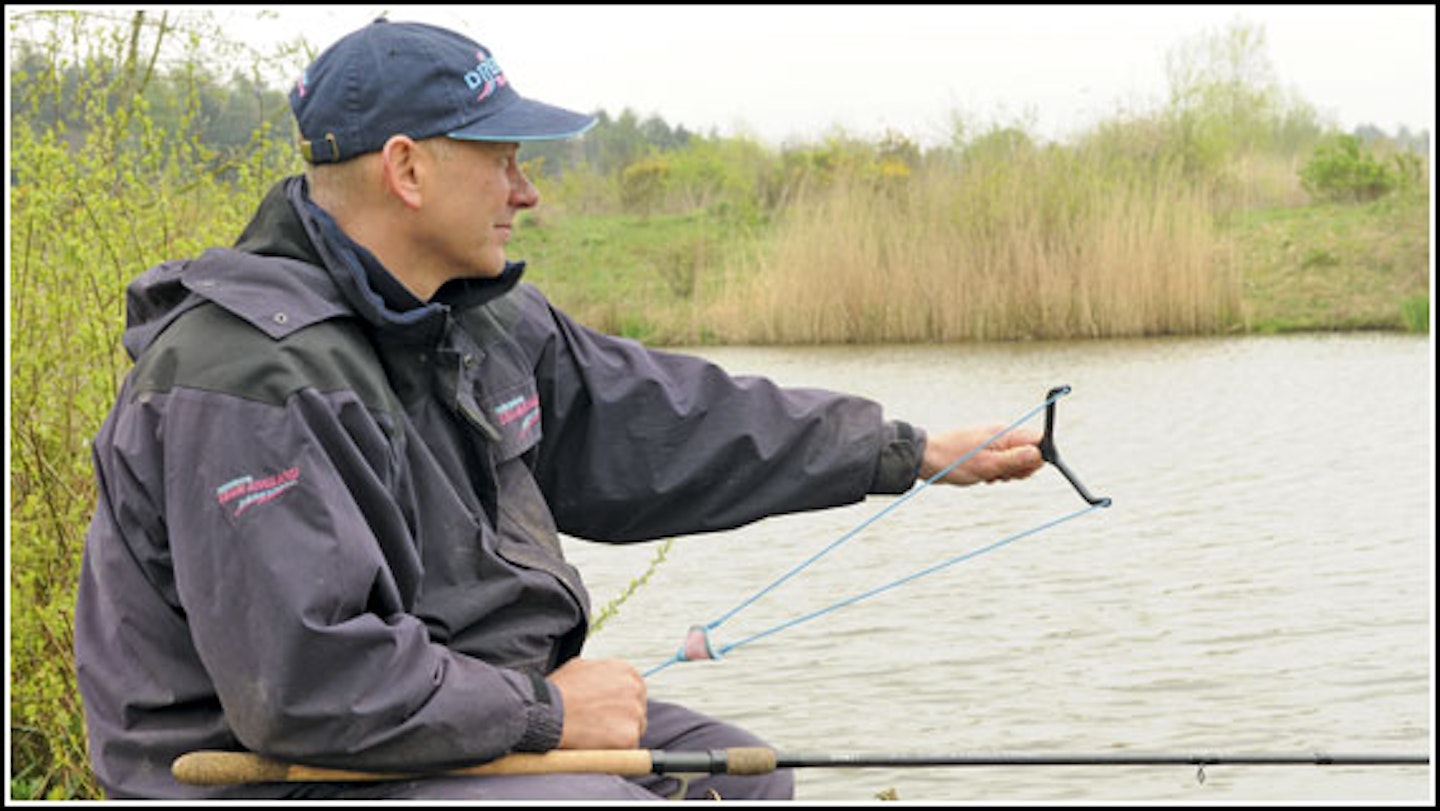The‘pellet waggler’ is a brilliant summer method of fishing up in the water for huge nets of match carp. But you’re always busy, so it isn’t a method for the work shy!
The idea is to suspend a hookbait a few inches to a few feet from the surface and constantly catapult bait around it. The carp will be attracted by the sound of the loosefeed, and of the float, splashing down on the water’s surface, and home in on the suspended hookbait.
The ability to feed accurately by catapult while still holding the rod is essential for this style of fishing.
Tackle
Because you’re targeting larger carp you need a more powerful rod than you use for general insert waggler fishing. A good pellet waggler rod should have a smooth, progressive action to soak up sudden lunges under the rod tip. Shorter rods will help you play and net big carp easier on smaller commercial fisheries. Top match ace Steve Hemingray uses an 11ft 6in Drennan Carp Waggler Combo rod coupled with a Daiwa ‘S’ reel loaded with sinking 4.4lb Drennan Float Fish line.
.jpg?auto=format&w=1440&q=80)
Float
Pellet waggler floats are shorter, fatter and more buoyant than standard wagglers and are designed to make a splash as they land. But they don’t dive too deep or spook fish swimming high up in the water.
There are many types available but Steve generally uses a Drennan No2 (3.5g capacity) Pellet Waggler which is locked on the line with two SSG (swan) shot. There are no dropper shot.
If possible, always choose an unloaded float. Loaded versions, with the weight built in at the base, dive deeper when they hit the water.
Again, make sure you use a float adaptor in case you want to switch to a lighter or heavier float without having to break the rig down.
Steve always fishes a hooklength, rather than ‘straight through’ in case he snags up or needs to tie on a different size or sharper hook.
.jpg?auto=format&w=1440&q=80)
Bait bands
The easiest way to put hard pellets on the hook is to use a flexible rubber/silicon bait band. The bands Steve uses have a special dimple at the point where the hookpoint is intended to pierce them.
There are two ways to mount the banded pellet – on the hook shank, or on the bend (see below).
On the day, one method may hook more fish than the other, so Steve always experiments with the position until he finds the most successful.
.jpg?auto=format&w=1440&q=80)
.jpg?auto=format&w=1440&q=80)
Step One
Pierce the hookpoint through the dimple on the bait band
Step Two
Stretch the band to make room for the pellet
.jpg?auto=format&w=1440&q=80)
.jpg?auto=format&w=1440&q=80)
Step Three
Try fishing with the bait band slid on to the hook’s shank...
Step Four
...or, slide it round the bend and see which works best on the day
.jpg?auto=format&w=1440&q=80)
Hooks and hookbait
A hard, 4mm or 6mm sinking pellet is a great hookbait for this style of fishing. Some fisheries insist that you can only use their own pellets, but there are loads of different types on the market. Steve uses Sensas Carp Pellets.
Steve swears by a Drennan size 14 Wide Gape Pellet hook. It’s a relatively light but enormously strong hook capable of landing big carp and the wide gape (the distance between the hookpoint and shank) tends to increase hook-up rates.
Depth
Whatever the depth of swim on typical, man-made commercial pools, Steve always starts off fishing his pellet waggler rig at 2ft deep. He says there are days when you will catch shallower or deeper, but not by much. A foot either side of that initial two feet depth will be all it takes!
Constant casting is the key
Carp come to the noise of the float splashing down, so Steve only leaves his float out there for 30 to 40 seconds before recasting. During that period he will also twitch his float twice, so the hookbait is always on the move.
The twitch
It takes only a few seconds for the pellet to fall two feet through the water and then remain static under the float.
Steve knows that carp are naturally curious and attracted to movement, so he wants his hookbait to stand out. He does this by flicking his rod tip firmly which snatches the float six inches to a foot across the surface, lifting the pellet back up in the water, only for it to drift downwards again.
Sometimes, you’ll get a bite immediately after twitching. As soon as he twitches the float, Steve reels in any slack line to keep a tight line to the float.
Feeding
Correct feeding is a critical part of this style of fishing and it is essential that you can catapult pellets while still holding the rod.
You are aiming to hit a metre-square target area around the float. Steve likes to fire out 6mm size pellets as they make a louder splash than 4mm pellets and they’re also easier to fire over longer ranges.
Aim to feed once or twice every cast but you only need to fire three or four pellets each time.
Sometimes, once you’ve got the fish in your swim, you can cut down on the feed and the carp will still come to the sound of your constant casting.
Every bite on this method will be lightning fast, but very rarely will fish hook themselves.
Unlike the insert waggler, if you see any type of movement in the pellet waggler, strike at it!
If you go a few casts without any indication, then you need to start putting in more bait.
The more you fish this method, the easier it will get!

Get into the rhythm!
The best pellet waggler anglers quickly drop into a work-intensive rhythm – cast, catapult, twitch, catapult, twitch, reel in, recast.
This can be physically draining but, at the end of the day, you could have landed well over 100lb of carp. So give it a go!
.jpg?ar=16%3A9&fit=crop&crop=top&auto=format&w=1440&q=80)